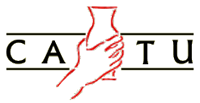Related Research Articles
In British politics, an affiliated trade union is one that is linked to the Labour Party. The party was created by the trade unions and socialist societies in 1900 as the Labour Representation Committee and the unions have retained close institutional links with it.

The Ceramic and Allied Trades Union (CATU) was a trade union representing pottery workers in the United Kingdom.

The Iron and Steel Trades Confederation (ISTC) was a British trade union for metal-workers and allied groups, being the largest union in these fields. It was formed on 1 January 1917 as a merger of existing steel-workers' unions and it is now part of Community.
Community is a British trade union which formed in 2004. The union represents workers in a diverse range of sectors, including iron and steel, justice and custodial, domestic appliance manufacturing, textiles and footwear, road transport, betting, the third sector as well as the self-employed.

The General Federation of Trade Unions (GFTU) is a national trade union centre in the United Kingdom. It has 35 affiliates with a membership of just over 214,000 and describes itself as the "federation for specialist unions".

The National Union of Dyers, Bleachers and Textile Workers (NUDBTW) was a trade union in the United Kingdom.

The Confederation of Shipbuilding and Engineering Unions (CSEU), often known as the Confed is a trade union confederation in the United Kingdom.
William Bromfield was an English trade unionist and Labour Party politician from Leek in Staffordshire. He was the town's Member of Parliament (MP) for all but four of the years between 1918 and 1945.

The Amalgamated Weavers' Association, often known as the Weavers' Amalgamation, was a trade union in the United Kingdom. Initially, it operated in competition with the North East Lancashire Amalgamated Weavers' Association in part of its area, and it was therefore nicknamed the Second Amalgamation.
The United Textile Factory Workers' Association (UTFWA) was a trade union federation in Great Britain. It was active from 1889 until 1975.
The Amalgamated Association of Beamers, Twisters and Drawers (AABTD) was a British trade union which existed between 1866 and 2002. It represented skilled workers in the cotton industry who were responsible for preparing warp yarns prior to weaving.
The history of trade unions in the United Kingdom covers British trade union organisation, activity, ideas, politics, and impact, from the early 19th century to the present.
The National Union of Textile Workers was a trade union representing workers in the textile industry in England, principally in Yorkshire.

The Amalgamated Society of Dyers, Finishers and Kindred Trades was a trade union representing dyers and workers in related jobs in the United Kingdom.
The Northern Counties Textile Trades Federation was a trade union federation in northern England.
The Blackburn and District Weavers' Winders' and Warpers' Association was a trade union representing cotton industry workers in Blackburn, Lancashire, in England. One of the earliest weavers' unions to endure, it formed a model that many others copied, and was at the centre of early attempts to form a regional federation of cotton trade unions.
The Oldham Provincial Card and Blowing Room and Ring Frame Operatives' Association was a trade union representing cotton industry workers in Oldham, Lancashire, in England. Long the largest union in the industry, it played a leading role in establishing a regional federation of cardroom workers.
James Stott was a British trade union leader, who became secretary of the International Federation of Textile Workers.
William Stubbs was a British trade union leader.
Herbert Lisle was a British trade union leader.
References
- 1 2 Labour Party, Report of the Forty-Fifth Annual Conference of the Labour Party, p.77
- 1 2 3 Marsh, Arthur (1984). Trade Union Handbook (3 ed.). Aldershot: Gower. pp. 352–353. ISBN 0566024268.
- 1 2 3 4 5 6 Burchill, Frank; Sweeney, Jim (1971). A History of Trade Unionism in the North Staffordshire Textile Industry. Stafford: University of Keele.
- 1 2 Eaton, Jack; Gill, Colin (1981). The Trade Union Directory. London: Pluto Press. pp. 183–184.
- ↑ Labour Party, Report of the Executive Committee (1918), pp.115
- ↑ Working Class Movement Library, "Silk workers' unions"
- ↑ Peter Carter and John B. Smethurst, Historical Directory of Trade Unions: Volume 6, p.116